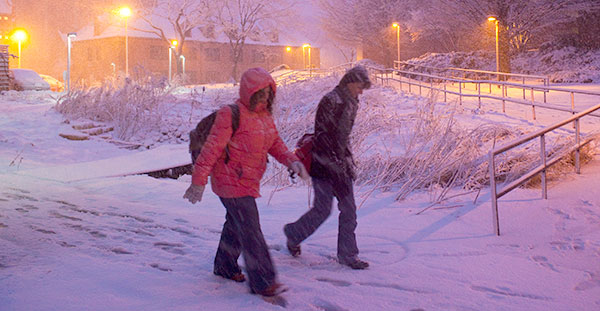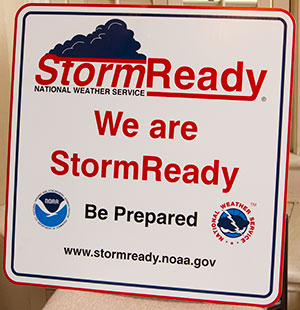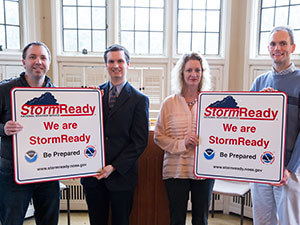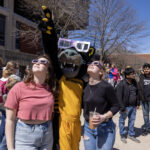

This winter, the university’s in-house atmospheric scientists will make at least one meteorological guarantee: UWM is the only StormReady® college or university in Wisconsin.
Representatives from the National Weather Service joined Mathematical Sciences Assistant Professor Clark Evans, Vice Chancellor for Finance & Administrative Affairs Robin Van Harpen and Innovative Weather Lead Meteorologist Mike Westendorf for a mid-November ceremony to present UWM with its official StormReady designation, plus the signage to prove it.
Signage locations are yet to be determined, but UWM is already on the list of just 16 StormReady sites in Wisconsin. Like the communities of New Berlin and Bayside, Fort McCoy and St. Croix County, UWM is being recognized for going above and beyond to prepare for severe weather events.
“StormReady communities are better prepared to save lives from the onslaught of severe weather through advanced planning, education and awareness,” according to a statement from the National Oceanic and Atmospheric Administration, which oversees the National Weather Service. “No community is storm proof, but StormReady can help communities save lives.”
Communication, coordination, innovation

The ability to anticipate severe weather, communicate potential hazards clearly to all affected parties, and easily coordinate law enforcement, administrative and meteorological resources to address severe weather are the foundation of any successful StormReady application.
“The campus has done a lot in the last three to five years, particularly among Innovative Weather, campus administration and University Police,” says Evans. “We’ve been putting a lot of pieces in place to handle severe and hazardous weather situations.”
A native Floridian who counts Wisconsin thunderstorms among his favorite local weather events, Evans helped UWM earn StormReady credentials after seeing the program directly benefit his graduate institution, Florida State University.
“Bringing all of the different groups together, we knew this was something good for UWM. To be the first in Wisconsin was icing on the cake.
“The hope now is that some of the things that are done here on campus will indirectly benefit the wider community and foster a greater level of weather awareness.”
What does it mean to be StormReady?
Specific StormReady® requirements include having the following:
• Twenty-four hour warning point and emergency operations center; provided by the UWM Police Department.
• Multiple methods to receive and disseminate severe weather warnings and information; provided primarily by Innovative Weather, with support from UWM Police.
• Various methods to monitor weather conditions locally; provided by Innovative Weather and other resources.
• A formal hazardous weather action plan, including severe weather spotter training and drills. UWM’s Emergency Operations and Hazardous Weather plans meet this criterion.
- Providing at least three annual weather safety talks and ensuring that there are trained weather spotters on campus; Innovative Weather and the student-run Atmospheric Science Club help facilitate these activities.
Some of the above were in place long before the certification process began, under the auspices of Innovative Weather, which provides UWM and multiple other local and regional organizations with high-quality, user-specific weather forecasts.
“Having our in-house meteorologists in the Innovative Weather team helped us earn this certification,” says Vice Chancellor for Finance & Administrative Affairs Robin Van Harpen. “It means we can move faster to coordinate and communicate a response to severe weather because we’re not just watching the news and waiting for the latest information. We’ve got access to expert weather resources right here on campus, and they’re connected to overall campus operations at all times.”






